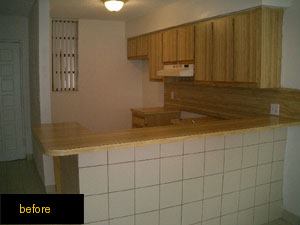Upon lease renewals, CAPREIT will offer residents small ways to improve their kitchens. Residents’ top suggestions at focus groups include under-the-counter coffee makers and CD players to free up counter space.
A New Footprint Sometimes adding a microwave or updating lighting isn’t enough. “It’s really market driven how far we will push in a kitchen,” says Scott Doyle, senior vice president of property management at Home Properties, a Rochester, N.Y.-based real estate investment trust.
To push the envelope, Home sometimes uses an open design – the latest trend in new construction. Walls on closed-in kitchens are torn down, opening up to eating areas or living rooms, and sometimes islands or breakfast bars are added.
Some residents in larger metropolitan markets, like the Washington and Philadelphia suburbs, are willing to pay for structural changes, which easily add up to $6,000 with new appliances, Doyle says. But since not all residents want to pay that kind of premium, Home will often extensively rehab just a limited number of units for those who want the upgrades.
As far as materials, Home looks for value. “Being a B, B-plus type of property, we are not overboard on fashion,” says Keith Knight, Home’s vice president, capital improvement and national accounts. “We try to keep it functional, clean, and very marketable.” Company properties tend to have white or almond bisque appliances and light oak cabinets, since lighter colors are easier to clean over time and brighten smaller kitchens. For countertops, there are an increasing number of laminates to choose from that mimic the look of granite and marble patterns.
Tough Job Desperate for Repair Years of neglect leave properties in bad shape, and affordable properties are particularly susceptible to this problem. The Chicago Housing Authority (CHA), for instance, is completely rehabbing 55 buildings for seniors that hadn’t been updated for 30 to 40 years. Kitchens in the 9,400-unit community contain beat-up stoves, broken cabinets, and peeling countertops.
With nearly $350 million from the U.S. Department of Housing and Urban Development (HUD), kitchens are getting new laminate cabinets, gas stoves with a self-cleaning oven, high-efficiency refrigerators, and laminate countertops. Eleven architectural firms are doing the plans and specs for the buildings. “The buildings generally were alike, but there were enough minor details that you just couldn’t have a cookie-cutter approach,” says August Chidichimo, CHA’s director of capital construction.
While HUD sets minimum standards for materials, CHA tries to go a step above the requirements, like using aluminum energy-efficient windows with Ultralift balances, which allow windows to be opened with 8 pounds of pressure instead of the typical 15 pounds. Rehabs cost $9,000 to $11,000 per kitchen, with ADA-compliant units costing slightly more. CHA plans to complete nearly all rehabs by the end of this year.
